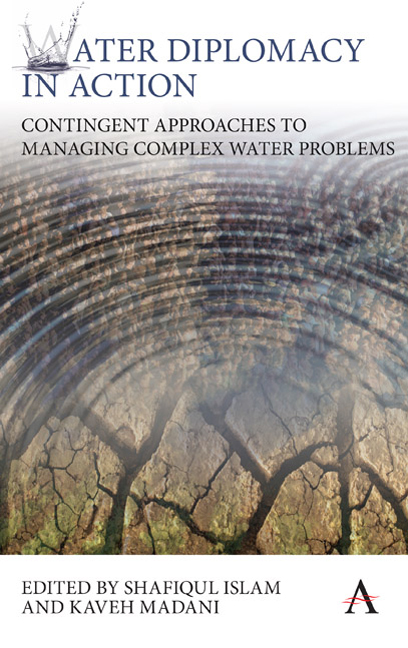Book contents
- Frontmatter
- Contents
- List of Figures
- List of Tables
- The Blind Men, the Elephant and the Well: A Parable for Complexity and Contingency
- Preface
- Part I ROOTS AND CAUSES OF COMPLEXITY AND CONTINGENCY IN WATER PROBLEMS
- Part II TOOLS, TECHNIQUES, MODELS AND ANALYSES TO RESOLVE COMPLEX WATER PROBLEMS
- Chapter Three Ten Bankruptcy Methods for Resolving Natural Resource Allocation Conflicts
- Chapter Four Flexible Design of Water Infrastructure Systems
- Chapter Five Extreme Value Analysis for Modeling Nonstationary Hydrologic Change
- Chapter Six The Water– Food Nexus and Virtual Water Trade
- Chapter Seven A Hybrid Analytical Approach for Modeling the Dynamics of Interactions for Complex Water Problems
- Chapter Eight A Call for Capacity Development for Improved Water Diplomacy
- Chapter Nine Water Complexity and Physics- Guided Data Mining
- Part III CASE STUDIES
- Notes on Contributors
- Index
Chapter Three - Ten Bankruptcy Methods for Resolving Natural Resource Allocation Conflicts
from Part II - TOOLS, TECHNIQUES, MODELS AND ANALYSES TO RESOLVE COMPLEX WATER PROBLEMS
Published online by Cambridge University Press: 10 January 2018
- Frontmatter
- Contents
- List of Figures
- List of Tables
- The Blind Men, the Elephant and the Well: A Parable for Complexity and Contingency
- Preface
- Part I ROOTS AND CAUSES OF COMPLEXITY AND CONTINGENCY IN WATER PROBLEMS
- Part II TOOLS, TECHNIQUES, MODELS AND ANALYSES TO RESOLVE COMPLEX WATER PROBLEMS
- Chapter Three Ten Bankruptcy Methods for Resolving Natural Resource Allocation Conflicts
- Chapter Four Flexible Design of Water Infrastructure Systems
- Chapter Five Extreme Value Analysis for Modeling Nonstationary Hydrologic Change
- Chapter Six The Water– Food Nexus and Virtual Water Trade
- Chapter Seven A Hybrid Analytical Approach for Modeling the Dynamics of Interactions for Complex Water Problems
- Chapter Eight A Call for Capacity Development for Improved Water Diplomacy
- Chapter Nine Water Complexity and Physics- Guided Data Mining
- Part III CASE STUDIES
- Notes on Contributors
- Index
Summary
Abstract
Bankruptcy methods aim to fairly allocate a stock among a group of agents, for cases in which the given amount is insufficient to fully satisfy all the agents’ demands. Natural resource allocation problems have certain characteristics that justify the use of bankruptcy methods for fair resource allocation. The approach is particularly appealing for situations in which natural resources are scarce or are exhausted beyond their capacity to meet the demands of various beneficiaries. To underline the utility of the bankruptcy theory in solving natural- resource allocation problems, this chapter reviews ten bankruptcy rules, namely: Proportional (P), Adjusted Proportional (AP), Constrained Equal Award (CEA), Constrained Equal Loss (CEL), Talmud (Tal), Piniles (Pin), Constrained Egalitarian (CE), Random Arrival (RA), Minimal Overlap (MO) and Generalized IBN Ezra (GIE). We apply these bankruptcy rules to determine the share of the five coastal states of the Caspian Sea— Azerbaijan, Iran, Kazakhstan, Russia and Turkmenistan— from its oil and natural gas reserves. Since the developed bankruptcy allocation solutions do not necessarily converge to the same resource share value for each negotiating party, developing bankruptcybased allocation solutions requires evaluating their acceptability in order to ensure practical relevance. Herein, we use the Bankruptcy Allocation Stability Index (BASI) to identify bankruptcy rules that can facilitate the decades- old Caspian Sea negotiation.
Introduction
Continuous socioeconomic growth across the world is increasing the pressure on natural resources. The demand for limited natural resources exceeds availability, creating a situation that parallels the financial bankruptcy problem. The financial bankruptcy problem occurs when an entity does not have sufficient assets to fully satisfy its debts. In essence, bankruptcy methods seek to find fair allocation solutions for distributing the remaining assets despite a shortage. Similar to the case of a bankrupt financial entity's failure, a natural resource stock, defined as the total amount of resource (e.g., the amount of water in a river), may be insufficient to meet the stakeholders’ claims or their desired share of the resource (e.g., water demand or right). Structuring natural- resource conflicts as bankruptcy problems can be appropriate in cases in which allocation rules are obscure or nonexistent.
- Type
- Chapter
- Information
- Water Diplomacy in ActionContingent Approaches to Managing Complex Water Problems, pp. 37 - 50Publisher: Anthem PressPrint publication year: 2017



